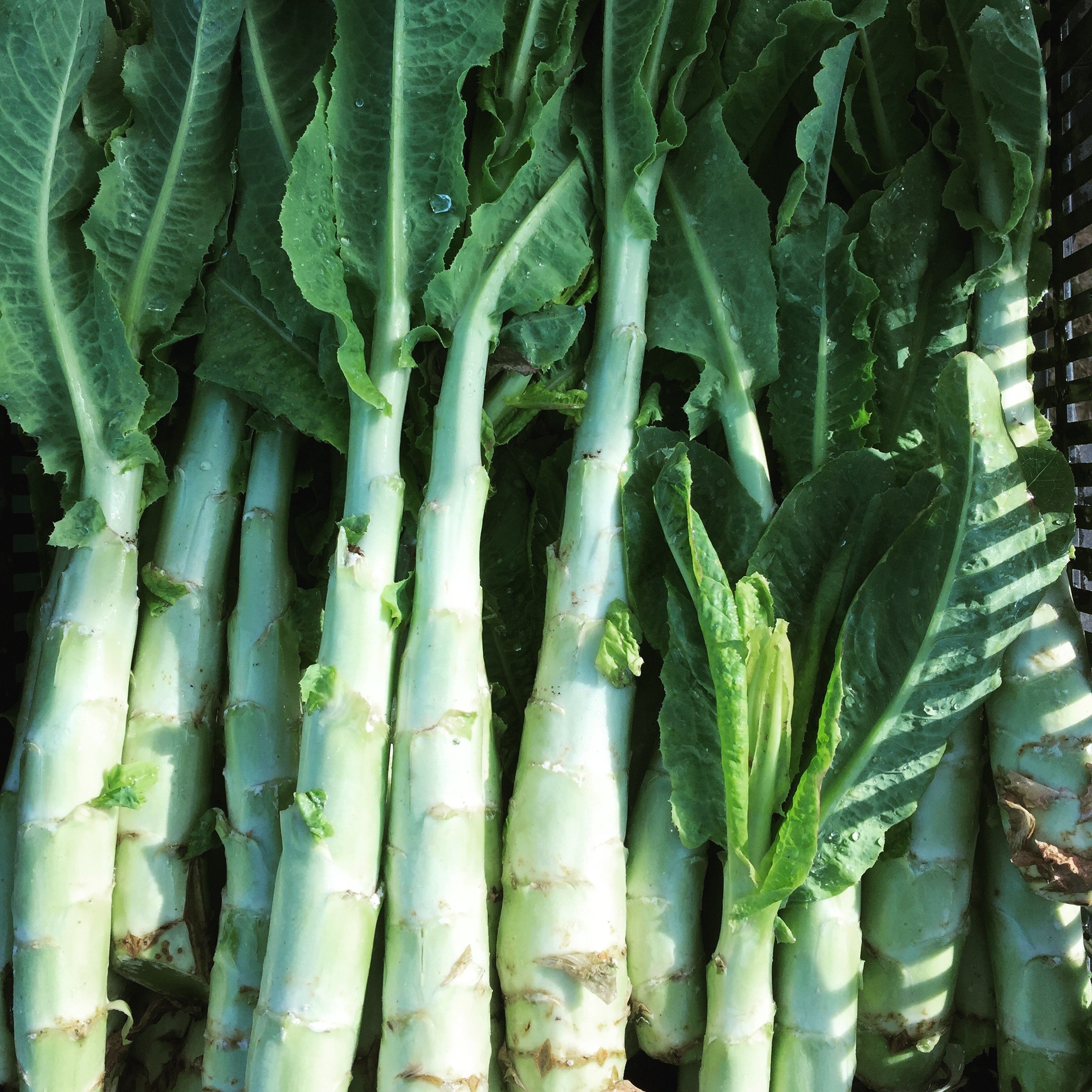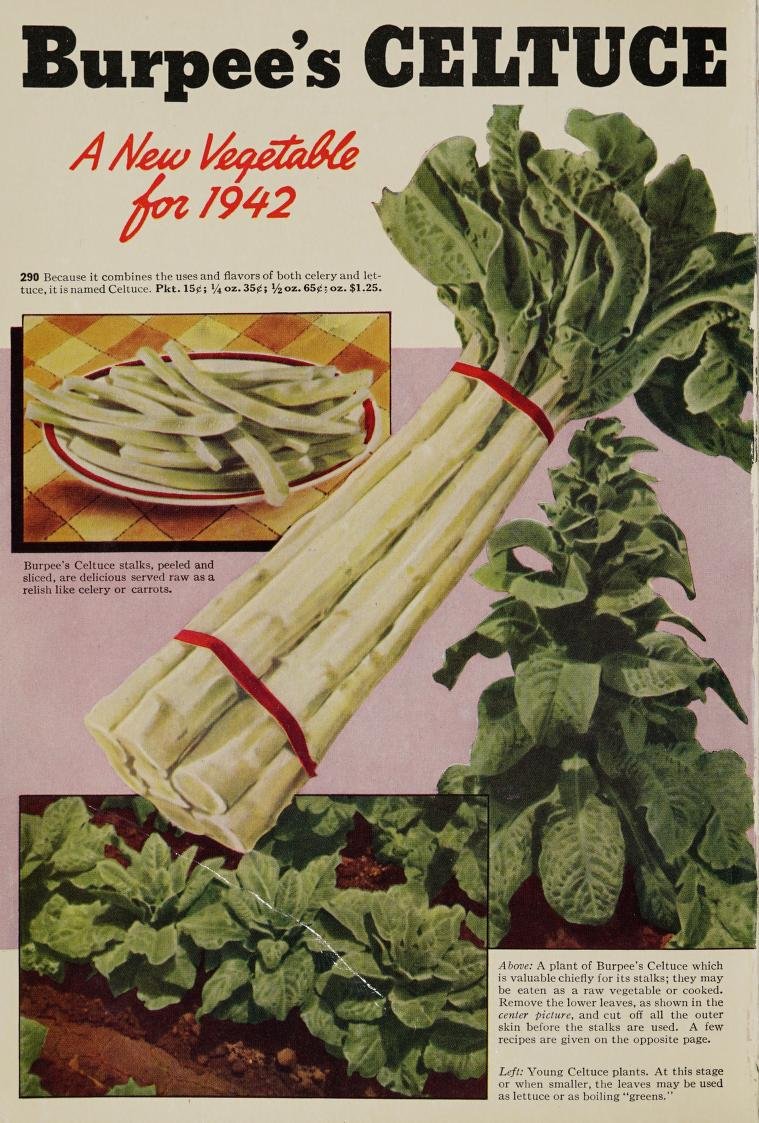Whoa! Woju!
In 1942, US based seed company, Burpee, released seeds for a novel variety of lettuce taken from China. They called it “Celtuce”, a portmanteau of celery and lettuce, an attempt to capture the unique flavor and texture for American audiences. While their splashy campaign failed to result in a breakaway success, celtuce has persisted, and is continually finding wider audiences who embrace the many delicious uses for their stems and leaves. But celtuce is not new or novel, as it’s been cultivated in China for over 1500 years, where the broad family is known as woju/萵苣.
Burpee’s Seed Company advertisement from 1942
The latin binomial for woju, as well as other types of lettuces is Lactuca sativa. Stem lettuce is further categorized as Lactuca sativa var. augustana. Some of the earliest record of cultivated lettuce is from Egypt around 2700 BC, where their seeds were used for oil (lettuce oil appears in ancient Egyptian materia medica), and the milky sap that informed its genus name, was used as a sedative. Bitter leaves were eaten before meals to aid digestion, but gradually, selection processes moved towards less bitterness. As lettuce made its way east, it found humans curious about the stem’s potential, resulting in a new branch of the plant’s evolution rooted in China circa 600 AD.
In China, both stems and leaves are harvested. Stems are referred to as wosun or qingsun, and leaves are called a-choy.
As a fresh market grower, celtuce became a major spring crop. While I loved growing them, there were a number of challenges I faced. One was the fact that many lettuces have some degree of photoperiodism. That is, that their bolting is related to the lengthening of days. This made succession planting challenging, as later successions tended to flower when stems were smaller, and the timing overlapped so that I had large amounts to harvest all at once. Instead of having several weeks of harvesting consistently sized stems, I had boatloads to get out of the field all at once to make sure the stems were harvested during the window when the stem had developed, before bitterness associated with maturing seed kicked in.
I spoke with growers in cooler climates to see if they too, faced this issue. Sure enough, many fellow growers expressed curiosity in having more varieties that could be planted within different segments of the season, to ensure more continual harvest at volumes appropriate for their respective market channels.
Problems can be alchemized into possibilities when we approach it as a plant breeding project! The feedback from growers helped highlight barriers that impacted how celtuce integrated into our farming operations. Exploring this crop was a perfect place to launch a collaboration with UC Davis’ organic plant breeding program, SCOPE. We have been in a process over the last few years, designing a multi-disciplinary approach to breeding Asian crops for organic systems, while deepening the relationships of Asian American communities to them. We co-facilitated a seminar bringing together plant science and Asian studies departments and designed a multi-year project exploring improvement areas for celtuce.
Having managed a commercial lettuce farm before starting my farm, I was keenly aware of the amazing diversity out there for head lettuce. Leaf shapes, colors, textures and combinations were seemingly endless. Different varieties thrived during different parts of the season, and each of those varieties could function in distinct ways. Many were versatile, used for both cut salad mix and whole heads. In what could be known as “My Year of Eating (Mostly, Only) Lettuce”, I appreciated the many ways I could incorporate lettuce into every meal and was delighted by things new to me, like grilling romaine or braising outer leaves we pulled off when packing.
Celtuce has its own very distinct personality, and in our current project, we wanted to ask ourselves and our communities, what traits need to be fixed/consistent, and what traits can we get creative with? Could we introduce more range of leaf shape, useage, and color while maintaining the texture and flavors of the stem?
Last year, we made several crosses both between different varieties of stem lettuce, as well as stem lettuce x head or loose leaf lettuce crosses. We tried to make as many crosses as possible to see the widest range of combinations. We kept the stem lettuce as the mother plant in all crosses, since variations in color, shape and texture of the leaves seems easier to introduce and stabilize.
In the long term, we hope to see an increased range of flowering times, and crossing celtuce types with head lettuce may help with developing some tendencies towards later bolting.
In the long, long term, once we have some stable varieties, we also hope to work towards some specific climate resilient traits. UCD Researcher, Luis Salazar, leads projects breeding salt tolerance into lettuce for commercial growers in Imperial Valley and the Central Coast. In the arid west, we have been heavily impacted by salt buildup in our soils and groundwater, due to continued drought, and the buildup of salts from fertilizer applications (it’s estimated up to 20% of arable land has experienced debilitating salinization, and that salinization has cost California agriculture $3.7B). This past spring he shared some of his findings of the factors influencing the ways different lettuces respond to salts, including some varieties’ remarkable ability to sequester salts in their root vacuoles. While for the next few years we are focusing on introducing novel combinations into our celtuce populations, we were inspired hearing from Luis, and the possibility of having some strategies moving forward to address this critical pressure.
Ok, back to the current season! Our team at UCD, Laura, Antonia and Lin, took the seed saved from those initial crosses last summer and grew them out over the winter in the greenhouse to increase the amount of seed we have this season to send to our farmers.
Some of our breeding lines!
This coming season we have a number of Asian-American farmers across the country participating in our trials. Huy Lin Lim, one of our Seed Fellows designed a template for us to collectively select for the traits we like, and to evaluate what lines will move forward to the next stage. We’ll be co-creating a matrix of agricultural traits like harvest window, flowering time, as well as stem size, weight and color; coupled with evaluations that let us know how each variety performs in the kitchen.
All of our projects work in this manner, bringing different parts of our communities together to think of charting a course forward for each crop we love. Farmers articulate the pressures we face, and what will help these varieties thrive in environments growing more chaotic by the moment. We distribute produce to different communities who share feedback that’s rooted in context. Our community partners know and love celtuce, they understand the different ways that culinary preparation has shaped its characteristics, and can help us ensure that it remains loyal to its history while being given the freedom to continually evolve.
-Kristyn
Watch Stacy Tang from Taiwan Bento in Oakland share two recipes for a-choy/a-tsai




